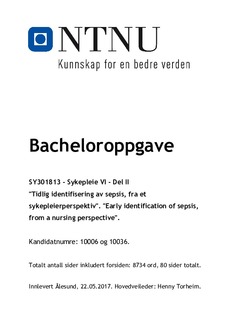| dc.contributor.advisor | Torheim, Henny | |
| dc.contributor.advisor | Skagøy, Bente Schei | |
| dc.contributor.author | Molnes, Veronika Kipperberg | |
| dc.contributor.author | Langerud, Synnøve | |
| dc.date.accessioned | 2017-10-24T13:21:00Z | |
| dc.date.available | 2017-10-24T13:21:00Z | |
| dc.date.issued | 2017 | |
| dc.identifier.uri | http://hdl.handle.net/11250/2461898 | |
| dc.description.abstract | Bakgrunn: 7000 personer får sepsis årlig i Norge, samtidig som det viser seg at
forekomsten er økende. Tidlig identifisering av sepsis kan bidra til å redusere
komplikasjonsrisikoen og bedre prognosen for pasienten.
Hensikt: Studiens hensikt er å belyse hvordan sykepleiere kan bidra med å identifisere
tidlige tegn på sepsis.
Metode: Vi har brukt systematisk litteratursøk, og har inkludert åtte forskningsstudier. De
åtte forskningsstudiene er både kvalitative og kvantitative, og belyser vår problemstilling.
Vi har også anvendt relevant pensumlitteratur og valgfri tilleggslitteratur.
Resultater: Sykepleiere er i nøkkelposisjon for å oppdage og gjenkjenne tidlig tegn på
sepsis. Mange sykepleiere mente at de hadde behov for å forbedre ferdigheter og
kunnskaper. Skreddersydde utdanningsprogram forbedret deltakernes kompetanse i å
håndtere pasienter med sepsis. I de pasientsituasjonene hvor det ble brukt
kartleggingsverktøy, var resultatet bedre enn i situasjoner det ikke ble benyttet.
Konklusjon: Ved å benytte seg av både kunnskaper, klinisk blikk og kartleggingsverktøy
kan sykepleiere bidra til å identifisere tidlige tegn på sepsis. Ved at sykepleierne har
kunnskaper om hvilke symptomer som kan forekomme ved sepsis, kan man også
identifisere og starte behandlingen tidligere. | nb_NO |
| dc.description.abstract | Background: 7,000 people develope sepsis every year in Norway, while it appears that the
incidence is increasing. Early identification of sepsis can help reduce the complications
and increase prognosis for the patient.
Purpose/Aim: The aim of this study is to discuss how nurses can be able to contribute in
the early identification of sepsis.
Method: In our literary research, we included eight research studies. The studies are both
qualitative and quantitative, and highlight our problem setting. In addition our study is
based up on relevant curriculum and optional literature.
Results: Nurses are in key position to detect and recognize early signs of sepsis. Many
nurses had the opinion that they were in need of improved skills and knowledge.
Customized education programs improved participants' skills in dealing with patients with
sepsis. Screening tools increased the results of early detection.
Conclusion: By utilizing both knowledge, clinical assessment and screening tools, nurses
can be able to contribute in the early identification of sepsis. As nurses have the
knowledge to recognize the symptoms that may occur in sepsis, they will be able to
identify and start treatment earlier. | nb_NO |
| dc.language.iso | nob | nb_NO |
| dc.rights | Attribution-NonCommercial-NoDerivatives 4.0 Internasjonal | * |
| dc.rights.uri | http://creativecommons.org/licenses/by-nc-nd/4.0/deed.no | * |
| dc.subject | Sepsis | nb_NO |
| dc.subject | Infeksjon | nb_NO |
| dc.subject | Identifisering | nb_NO |
| dc.subject | Kartleggingsverktøy | nb_NO |
| dc.subject | Behandling | nb_NO |
| dc.title | "Tidlig identifisering av sepsis, fra et sykepleierperspektiv". | nb_NO |
| dc.title.alternative | "Early identification of sepsis, from a nursing perspective". | nb_NO |
| dc.type | Bachelor thesis | nb_NO |
| dc.subject.nsi | VDP::Medisinske Fag: 700::Helsefag: 800::Sykepleievitenskap: 808 | nb_NO |
| dc.source.pagenumber | 80 | nb_NO |

